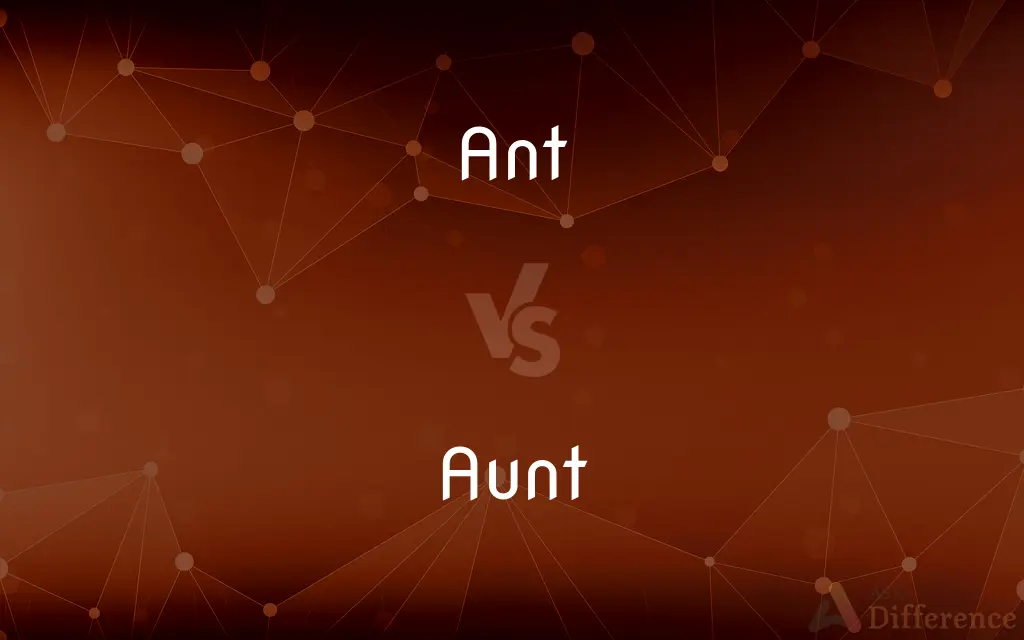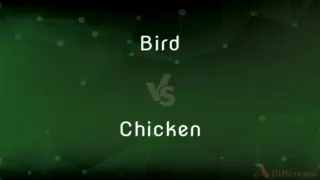Ant vs. Aunt — What's the Difference?
By Tayyaba Rehman & Urooj Arif — Updated on April 26, 2024
Ants are small, social insects known for their structured colony life, while an aunt is a familial term for a woman related by blood or marriage.

Difference Between Ant and Aunt
Table of Contents
ADVERTISEMENT
Key Differences
Ants belong to the Formicidae family within the order Hymenoptera, known for their complex social structures and ability to work collectively. In contrast, an aunt is a familial term referring to the sister of one’s parent or the wife of one’s uncle, emphasizing a human relational connection.
Ant colonies operate under a caste system, typically consisting of workers, soldiers, and a queen, each with specific roles, illustrating a highly organized societal structure. Whereas an aunt's role in the family varies culturally and individually but often includes caregiving, mentorship, and familial support.
In biological terms, ants can be found in diverse environments worldwide, adapting to various ecosystems from rainforests to deserts. On the other hand, the concept of an aunt exists universally across human societies, adapting culturally to fit different family structures and societal norms.
Ants communicate through pheromones, sounds, and touch, which are crucial for their survival and efficiency as a colony. In contrast, an aunt communicates through language and emotional expressions, fostering relationships within the human family.
The study of ants, myrmecology, offers insights into the fields of ecology, sociology, and even robotics, due to ants' complex behaviors and efficiency. Conversely, the role of an aunt is studied within anthropological and sociological contexts, focusing on human familial and social relationships.
ADVERTISEMENT
Comparison Chart
Definition
A small insect in the family Formicidae.
A woman related by blood or marriage to one’s parent.
Social Structure
Operates in a highly organized caste system.
Role varies by individual and culture.
Habitat
Found in nearly all terrestrial ecosystems.
Exists universally across human societies.
Communication
Uses pheromones, sounds, and touch.
Uses verbal and non-verbal human communication.
Area of Study
Myrmecology (study of ants).
Anthropology and sociology (study of human relations).
Compare with Definitions
Ant
Ant colonies have a single queen whose primary role is reproduction.
The ant queen lays thousands of eggs during her lifetime.
Aunt
An aunt is a sister to one's father or mother or married to one's uncle.
She visited her aunt during the holidays.
Ant
Worker ants are responsible for gathering food and maintaining the nest.
Worker ants were seen carrying leaves back to their colony.
Aunt
Aunts often play a significant role in childcare within many cultures.
Her aunt taught her how to read.
Ant
Ants are eusocial insects known for their cooperative colonies.
An ant can lift 20 times its body weight.
Aunt
Aunts can be maternal or paternal, relating to the mother’s or father’s side of the family.
Her maternal aunt is her godmother.
Ant
Some ant species engage in agriculture, such as farming fungi.
Leafcutter ants cultivate fungus by feeding it with fresh leaves.
Aunt
In some families, aunts act as second mothers to their nieces and nephews.
Her aunt was more like a mother to her.
Ant
Ants communicate using chemical signals called pheromones.
Ants follow a pheromone trail to find food sources.
Aunt
The role of an aunt can vary significantly across different cultures and families.
In her culture, her aunt plays a key role in wedding preparations.
Ant
Ants are eusocial insects of the family Formicidae and, along with the related wasps and bees, belong to the order Hymenoptera. Ants appear in the fossil record across the globe in considerable diversity during the latest Early Cretaceous and early Late Cretaceous, suggesting an earlier origin.
Aunt
An aunt is a woman who is a sibling of a parent or married to a sibling of a parent. Aunts who are related by birth are second-degree relatives.
Ant
Any of numerous hymenopteran insects of the family Formicidae, characteristically having wings only in the males and fertile females and living in colonies that have a complex social organization.
Aunt
The sister of one's father or mother.
Ant
Any of various insects in the family Formicidae in the order Hymenoptera, typically living in large colonies composed almost entirely of flightless females.
Aunt
The wife of a sibling of one's mother or father.
Ant
(Internet) A Web spider.
Aunt
Used as a form of address for an older woman, especially by children.
Ant
(ornithology) To rub insects, especially ants, on one's body, perhaps to control parasites or clean feathers.
Aunt
The sister or sister-in-law of one’s parent.
Ant
A hymenopterous insect of the Linnæan genus Formica, which is now made a family of several genera; an emmet; a pismire.
Aunt
The female cousin or cousin-in-law of one’s parent.
Ant
Social insect living in organized colonies; characteristically the males and fertile queen have wings during breeding season; wingless sterile females are the workers
Aunt
(affectionate) A woman of an older generation than oneself, especially a friend of one's parents, by means of fictive kin.
Aunt
(obsolete) Any elderly woman.
Aunt
(obsolete) A procuress or bawd.
Aunt
The sister of one's father or mother; - correlative to nephew or niece. Also applied to an uncle's wife.
Aunt
An old woman; and old gossip.
Aunt
A bawd, or a prostitute.
Aunt
The sister of your father or mother; the wife of your uncle
Common Curiosities
How do ants communicate?
Ants communicate through chemical signals (pheromones), tactile signals, and sometimes auditory signals.
How do ants find their way back to their colony?
Ants use a combination of visual landmarks, the position of the sun, and pheromone trails to navigate back to their colony.
What are the main roles of an ant in its colony?
Worker ants gather food, soldiers protect the colony, and the queen reproduces.
What is the primary role of an aunt in a family?
The role varies but typically includes providing support, mentorship, and sometimes childcare.
How does the role of an aunt differ in different cultures?
Cultural norms and family structures heavily influence an aunt’s role, ranging from a supportive family member to a secondary caregiver.
What environmental role do ants play?
Ants are crucial for soil aeration, seed dispersal, and as a food source for many species, playing significant ecological roles.
Can ants live alone?
No, ants are eusocial insects that thrive in colonies and cannot survive alone for long.
Do ants sleep?
Ants have periods of rest where their activity levels decrease significantly, but these are not sleep in the human sense.
What types of ants are commonly found around the world?
There are many types of ants worldwide, including fire ants, carpenter ants, and black garden ants, each adapted to specific environments.
What is the lifespan of an ant?
The lifespan of ants varies by species; worker ants may live a few weeks to months, while queens can live for several years.
How do families typically define the role of an aunt?
Families typically view aunts as supportive figures who offer care, guidance, and additional familial bonding outside of the immediate nuclear family.
Can a woman be an aunt if she has no biological nieces or nephews?
Yes, women can also be considered aunts in a broader sense if they are close to the children of friends or other family members, often referred to as "honorary aunts."
Share Your Discovery

Previous Comparison
Metallic vs. Silver
Next Comparison
Bird vs. ChickenAuthor Spotlight
Written by
Tayyaba RehmanTayyaba Rehman is a distinguished writer, currently serving as a primary contributor to askdifference.com. As a researcher in semantics and etymology, Tayyaba's passion for the complexity of languages and their distinctions has found a perfect home on the platform. Tayyaba delves into the intricacies of language, distinguishing between commonly confused words and phrases, thereby providing clarity for readers worldwide.
Co-written by
Urooj ArifUrooj is a skilled content writer at Ask Difference, known for her exceptional ability to simplify complex topics into engaging and informative content. With a passion for research and a flair for clear, concise writing, she consistently delivers articles that resonate with our diverse audience.
















































